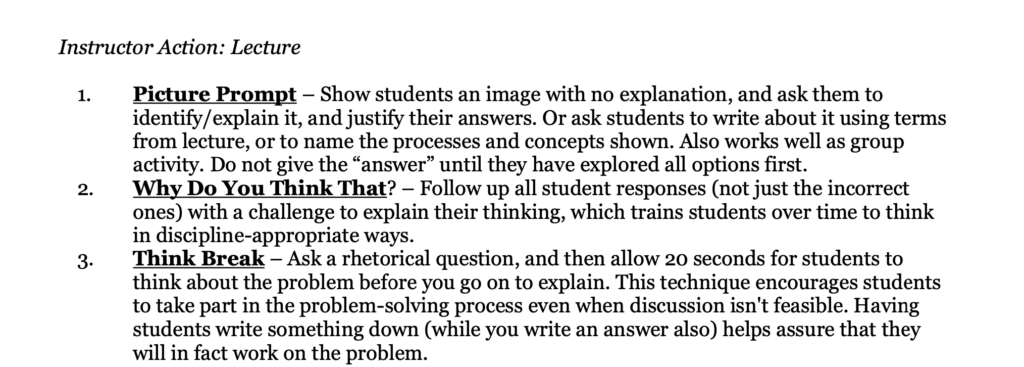
Photo by Jakob Owens on Unsplash
This week was a little odd, we had a last minute cancellation from a guest speaker, so our presentation was a little less polished than normal. I think the greatest benefit of the lesson was the list of resources Michael put together in his slides for creating engaging lessons – I’ll be saving this and pulling from in moments of need!
I particularly like this list of interactive learning techniques from Kevin Lee: https://www.usf.edu/atle/documents/handout-interactive-techniques.pdf

What we covered was basically the use of video and images, as well as adjacent mediums like gifs to improve learning. Michael discussed the “right” (I’m putting this in quotation because I disagree, I’ll discuss why later!) way to use video, suggesting short videos in the 2-4 minute range as the sweet spot for leaners, while longer video should be assigned as homework. He highlighted benefits of video, like being able to visualize and slow down processes we can’t normally see, for example there is a great video showing DNA transcription that I saw shown in a high school. He also covered some logistics of graphics editing using powerpoint software, and creating your own learning videos through screencasting or other methods. I plan to do a screencasting demo soon and will be posting about the process here! What’s great about this method is it allows students to rewatch, pause, or slow down the instruction and review at their own pace.
Why Incorporate Multimedia in Lessons?
The obvious answer is, that it’s more engaging than simply listening to someone speak for a hour +. We dove into a bit on multimedia learning theory and how technology can help learning. We discussed Dual Code theory which we have also talked about in Ed Psych. Dual Code theory is that people learn best when auditory and visual information is presented, rather than just one or the other. We talked about Constructive Alignment, or centring all parts of a lesson, activities, and assessment around learning goals, something incredibly similar to the “Backwards Design” model we are learning in other classes.
What’s my current philosophy?
Okay, back to the 2-4 minute video segments in class thing. I disagree with this simply because I don’t believe in assigning kids (much) homework. For university? Awesome. Absolutely assign the film for homework. For a 14 year old? Kids lives are so much busier now than they were back in the early 2000s when I was in school. I remember doing a little bit of math homework from time to time, and maybe working on a fun video project, but most of my time outside of school was spent playing sports, hanging out with friends, reading, and generally enjoying life. As a 30 year old who’s life now consists mostly of working, getting ready for work, and getting to and from work (come on, I know you can relate!), I’m a strong proponent of making kids lives just a little less hard. They’ll be busy soon enough!
I also think that subject matters a lot when discussing how to incorporate video. What I like about using film in social study classes, is that documentaries can provide a deep-dive into different social and cultural contexts than what my kids might normally be exposed to. While I’m going to be pulling on my own identity, experiences, and subject matter specialties, they can also help move beyond my own personal context. Whether it’s a documentary on Indigenous Land Defenders, or politicians in Ottawa, documentary films can really provide a nuanced perspective on the lived experience of diverse groups, and give kids and “insider look”. I do think it makes sense in a biology class to keep instructional videos short – but I think this is less applicable to a subject that is, at it’s core, about understanding the history and diversity of society. For social, I think that’s the greatest benefit of technology, it allows us to reach further outside of ourselves and our own experiences. So yes, I’ll play a full movie in class if I think it’s the best medium through which to introduce a topic.
Sorry, but comments are not enabled on this site.